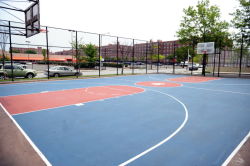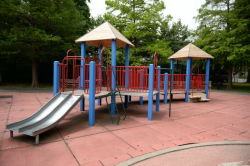Lopez Playground
Beavers in New York City - Lopez Playground
In the early 17th century, the Dutch East India Company sent navigator Henry Hudson westward to discover the Northwest Passage to the Orient. Instead, he landed in New York, finding natives dressed in deerskin, otter, and beaver. Fur was very popular in Holland at the time, but could only be acquired from Russia at a high price, and thus in 1610, a fur trade was created between the Dutch and Native Americans. This burgeoning fur trade provided the economic impetus for the establishment of the colony of New Amsterdam. As an acknowledgement of the beaver’s role in the establishment of New York City, it is depicted on the City seal and flag, which can be seen flying on the flagpole with yardarm in Lopez Playground. Unfortunately, the beaver disappeared from the city – human demand for its skin and competition for its habitat led to its eradication.
The North American beaver (Castor canadensis) is the largest rodent in North America. Almost entirely aquatic, the beaver’s webbed feet, body shape, and tail help it to swim powerfully and efficiently. The beaver can communicate by slapping its large, flattened tail against the water and by depositing scents. It has distinctive incisors, which can grow back as quickly as they are worn down. These strong teeth allow the beaver to cut down trees for construction and nourishment. Beavers work day and night, building and repairing dams and lodges, thus the phrases “busy as a beaver” and “eager beaver.” These structures have a great effect on the aquatic habitat by regulating water levels and promoting ecological diversity.
Beavers live in family units similar to those of humans. Males and females have long-term monogamous relationships and live with their offspring for up to two years in groups called colonies. Beavers put great effort into parental care, so their young are able to work independently by the time they leave the colony. Beavers are able to swim just a few hours after their births, however their small size and thick fur – they are born with a full coat – make it hard to travel long distances.
In 1600, there were as many as 100 million beavers in North America. However, their population decreased as a result of the growing fur trade. In the late 18th century, felt hats made from beaver fur became very popular. Increased trappings finally proved too much for the beaver population, as the animal became extinct east of the Mississippi by 1800. The beaver, which influenced much of New York City’s history, was eliminated from the city by a species they originally attracted to the site, humans.
Check out your park's Vital Signs
Clean & Safe
Green & Resilient
Empowered & Engaged Users
Share your feedback or learn more about how this park is part of a
Vital Park System



